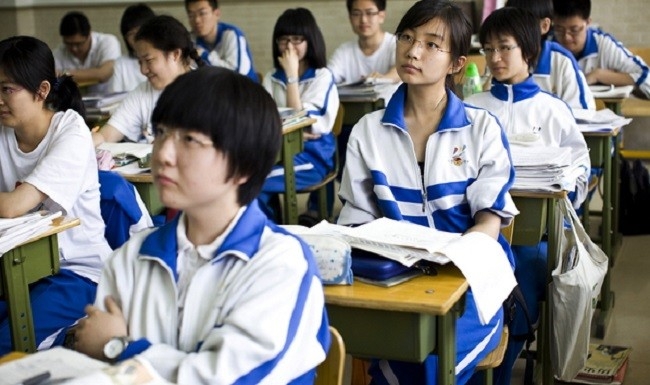AsianScientist (Jun. 2, 2015) – By Crispin Maslog – Students from five nations and territories in Asia have topped the latest global school rankings in science and math conducted by the OECD (Organization of Economic Co-operation and Development).
The top five are Singapore, Hong Kong, South Korea, Japan and Taiwan (the last two tied in fourth place). The surprise is Vietnam, which follows in 12th place, ahead of such developed Western countries as the United Kingdom (20th) and the United States (28th). Only two other Asian countries are included in the rankings this year—Thailand (47th) and Indonesia (69th).
The release of the rankings was timed with the World Education Forum sponsored by the UNESCO (UN Educational, Scientific and Cultural Organization) last 19-22 May in Incheon, Korea. The rankings are based on the Program for International Student Assessment (PISA) taken by 15-year-olds around the world every three years.
OECD suggests a correlation between quality basic education and economic development—the better educated a country’s people are, the faster the country develops economically. Why 5 Asians topped Nanyang Technological University's Professor Ang Peng Hwa has an explanation for the superior performance of Singapore students.
“We invented the Singapore math where students learn it in a way that is easier to grasp intuitively, easier to remember and easier to apply. The method is so different from what I learned in school that teachers tell parents NOT to teach the students. It is a method used in top schools in the US,” Ang tells SciDev.Net. Aside from the Singapore math method, quality of teaching comes into play.
Ang adds: “I will not say that we have the best people being trained and hired as teachers. But we have, for example, made it a requirement to have a degree to teach in high schools.” Another factor for Singapore’s superior performance, perhaps, is its culture of achievers. “There is a national social stress on education. Most students have after-school tuition.
Getting a bottom grade is embarrassing. The [government] ministers have got good grades from kindergarten. Schools are rewarded for good academic performance,” Ang says. The same environment is true for Hong Kong, South Korea and Japan. After-school tuition is a way of life for students there who have to pass national exams to enter the universities. On Asians monopolizing the top five positions in the OECD rankings, Ang cites Singapore's founder Mr. Lee Kuan Yew’s theory of unique Asian values. Lee once claimed that countries using the Chinese written script did better in math and science.
In these countries, imbued with Confucianism, education is stressed as the way to get ahead. “If you go to an Asian classroom, you’ll find teachers who expect every student to succeed. There’s a lot of rigor, a lot of focus and coherence. These countries are also very good at attracting the most talented teachers in the most challenging classrooms, so that every student has access to excellent teachers,” said OECD education director, Mr. Andreas Schleicher.
Asian students in the US In the US, where I lived with my daughter and her family for the past ten years, her kids are topping their science, math and reading classes in grade school. And every year when national test results are out, I read in the newspapers about Asian students topping the lists. Most of these students have parents who are first generation migrants from Asia.
This phenomenon has sparked debate in the US about what’s wrong with American basic education. “Top US students are falling behind even average students in Asia. I emphasize Asia because Asian countries (or sub-entities) now dominate the top ten in all subjects: math, reading and science,” said Ms. Jill Barshay, Hechinger Report contributing editor and founder of the blog Education By The Numbers. Barshay’s blog quotes one of its American readers: “Cultural difference must account for many of the differences in test scores.
There must be something to the Asian stereotype of prizing hard work and perseverance that is playing out in PISA test scores now.” By contrast, American culture prizes some sort of notion of inherent ability and being able to do things effortlessly and quickly. Asian classrooms also benefit from a culture of good behavior where “more classroom time can be devoted to instruction.” “It’s not the (American) education system that is broken.
It is parenting. There was a time when parents made sure homework was done and children were reading instead of sitting in front of the TV,” said another American blog reader. But another blog reader chimes in: “I am a teacher in Korea and have been one in China as well and I have witnessed the selection of the test takers, which is empirical information that the stats don’t reveal… These countries try to save face, so they send the best to take the test.
In addition, I have friends who were teachers in Taipei, same is true there.” I don’t know where exactly the truth lies. But it is worth searching for answers to the question of why these five Asian nations are on top of the science and math rankings, the same ones that are now leading global growth.
———
Source: SciDev.Net.
Disclaimer: This article does not necessarily reflect the views of AsianScientist or its staff. Read more from Asian Scientist Magazine at: http://www.asianscientist.com/2015/06/features/asian-students-excel-maths-science/












प्रतिक्रिया